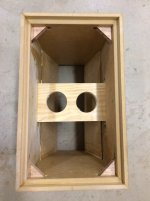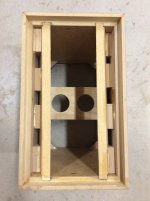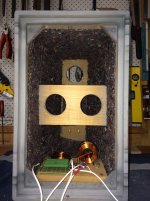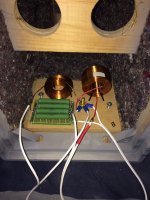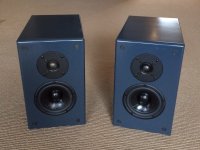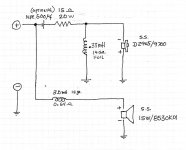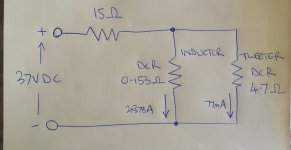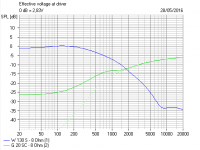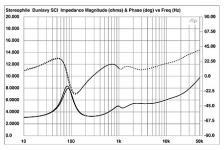I had a pair of surplus Scan Speak D2905-9500 tweeters that needed a home. After asking for a suitable 2-way design on this forum I decided to build a pair of Carl Richard’s original design “Intimates”. You can see Carl’s description of the speakers here: Introducing the "INTIMATES" (high WAF & quality sound) - Techtalk Speaker Building, Audio, Video Discussion Forum
These use Scan Speak “Revelator” 15W/8530K01 mid-woofers in a 15L (0.5cuft) ported cabinet with a “capacitor-less” first-order crossover. I built my own cabinets out of MDF with angled internal panels to mirror the internal dimensions of the Dayton Audio TWC-0.5CH curved-sided cabinets that Carl used. My cabinet walls are 18mm MDF. The baffle board is 25mm MDF.
The cabinets are finished with charcoal grey 80% sheen auto acrylic paint. It turned out a bit too battleship-grey looking for my liking. I wish I had used an off-white or cream colour. Oh well.
The Revelators blew my budget out of the water, so I went a bit cheap on the crossover inductors. I didn’t use foil for the tweeter inductor and I went slightly thinner on the woofer inductor wire. I mounted four parallel 47Ω 10W resistors so I can tweak the tweeter response. I’m currently only using three of the resistors to give about 15 ohms and the woofer/tweeter balance sounds pretty good.
The cabinets are fully lined with thick felt from a furniture removalist’s blanket. I haven’t added any stuffing or played with the port length yet. The port is 2” diameter and 9” long (50mm x 225mm).
I really like the sound of these speakers. The Revelators give them plenty of punchy bass and my ears are well used to the D2905 tweeters after listening to them for the last 10 years in my Ariel 6Cs. I’m listening to Tubular Bells as I type this (showing my age!). This piece has a lot of interesting sounds and I’m hearing stuff I haven’t noticed before. Acoustic guitar sounds superb. In fact, I’m starting worry I might like them more than my LX Minis!
Total cost was AUD1050 (although I already had the tweeters).
These will most likely end up wall-mounted in my workshop. Yeah, I know they are expensive workshop speakers, but I listen to music for hours at a time in my workshop. I like a lot of bass and I think these will perform well. They don't seem to be fatiguing based on the listening I have done so far. The Revelators have a sticky coating on the cones, so I will have to make grilles to keep the wood dust off them.
I'll post some pics below.
These use Scan Speak “Revelator” 15W/8530K01 mid-woofers in a 15L (0.5cuft) ported cabinet with a “capacitor-less” first-order crossover. I built my own cabinets out of MDF with angled internal panels to mirror the internal dimensions of the Dayton Audio TWC-0.5CH curved-sided cabinets that Carl used. My cabinet walls are 18mm MDF. The baffle board is 25mm MDF.
The cabinets are finished with charcoal grey 80% sheen auto acrylic paint. It turned out a bit too battleship-grey looking for my liking. I wish I had used an off-white or cream colour. Oh well.
The Revelators blew my budget out of the water, so I went a bit cheap on the crossover inductors. I didn’t use foil for the tweeter inductor and I went slightly thinner on the woofer inductor wire. I mounted four parallel 47Ω 10W resistors so I can tweak the tweeter response. I’m currently only using three of the resistors to give about 15 ohms and the woofer/tweeter balance sounds pretty good.
The cabinets are fully lined with thick felt from a furniture removalist’s blanket. I haven’t added any stuffing or played with the port length yet. The port is 2” diameter and 9” long (50mm x 225mm).
I really like the sound of these speakers. The Revelators give them plenty of punchy bass and my ears are well used to the D2905 tweeters after listening to them for the last 10 years in my Ariel 6Cs. I’m listening to Tubular Bells as I type this (showing my age!). This piece has a lot of interesting sounds and I’m hearing stuff I haven’t noticed before. Acoustic guitar sounds superb. In fact, I’m starting worry I might like them more than my LX Minis!
Total cost was AUD1050 (although I already had the tweeters).
These will most likely end up wall-mounted in my workshop. Yeah, I know they are expensive workshop speakers, but I listen to music for hours at a time in my workshop. I like a lot of bass and I think these will perform well. They don't seem to be fatiguing based on the listening I have done so far. The Revelators have a sticky coating on the cones, so I will have to make grilles to keep the wood dust off them.
I'll post some pics below.
Here is Carl's crossover. I used wire inductors of a slightly smaller gauge.
I haven't included the 500uF capacitor (yet). In terms of DC protection for the tweeter, wouldn't the parallel inductor protect the tweeter just as well as a series cap? I'm thinking the inductor would present an almost short circuit to a DC signal and should shunt almost all of the current to ground. Therefore the 15ohm resistor would dissipate all of the DC power instead of the poor tweeter.
I haven't included the 500uF capacitor (yet). In terms of DC protection for the tweeter, wouldn't the parallel inductor protect the tweeter just as well as a series cap? I'm thinking the inductor would present an almost short circuit to a DC signal and should shunt almost all of the current to ground. Therefore the 15ohm resistor would dissipate all of the DC power instead of the poor tweeter.
Attachments
Last edited:
Those resistors are going to get hot. Hope you mounted them in a way that air circulates all around them! 🙂
Great looking job. Let's 'hear' your thoughts on how they sound.
Great looking job. Let's 'hear' your thoughts on how they sound.
Just to be clear, Chris's Intimates build is the Ver. 1. There were two subsequent versions with other tweeters and all new XO's. He Built ver. 1 simply because that was the one with the SS dome tweeters he had on hand. Ver. 2 had ring radiator tweeters and ver. 3, Mundorf AMT tweeters.
Those resistors are going to get hot. Hope you mounted them in a way that air circulates all around them! 🙂
Yes, I set them about 5mm off the board. They have a 30W rating between the 3 of them, so they should be OK. Just for fun I might attach a thermocouple probe to them and measure temperature rise.
Here is Carl's crossover. I used wire inductors of a slightly smaller gauge.
I haven't included the 500uF capacitor (yet). In terms of DC protection for the tweeter, wouldn't the parallel inductor protect the tweeter just as well as a series cap? I'm thinking the inductor would present an almost short circuit to a DC signal and should shunt almost all of the current to ground. Therefore the 15ohm resistor would dissipate all of the DC power instead of the poor tweeter.
Chris,
Get XSim and try your theories out. In particular, try removing the tweeter cap, and examine the speaker impedance! 🙂
Best,
Erik
Hi Erik,
Thanks for the tip. I downloaded XSim and had a play. It's a great program.
It shows what I expected- at frequencies approaching DC the 500uF cap has very high impedance. Hence it will block DC and protect the tweeter.
However, at similar frequencies the parallel inductor's impedance drops, causing it to take a higher share of the current. With a DC input it acts like a 0.153 ohm resistor. I don't know how to model this in XSim, so I've attached a hand drawn picture.
Assuming the output of my amplifier went to full rail voltage of 37VDC, there should only be 77mA flowing through the tweeter. Maybe that is still enough to fry a tweeter?
Thanks for the tip. I downloaded XSim and had a play. It's a great program.
It shows what I expected- at frequencies approaching DC the 500uF cap has very high impedance. Hence it will block DC and protect the tweeter.
However, at similar frequencies the parallel inductor's impedance drops, causing it to take a higher share of the current. With a DC input it acts like a 0.153 ohm resistor. I don't know how to model this in XSim, so I've attached a hand drawn picture.
Assuming the output of my amplifier went to full rail voltage of 37VDC, there should only be 77mA flowing through the tweeter. Maybe that is still enough to fry a tweeter?
Attachments
You are forgetting what would go through the amp. 🙂
You don't model it, it's modelled for you. Enter your schematic. For each part there is a "Tune" option. For the coils, it allows you to enter DCR as well as inductance. For caps you enter capacitance and ESR. For resistors, Ohms and Watts (but it doesn't do anything with the watts).
You will get an impedance chart.
Stop attaching hand drawn pictures!! That's so late 20th century. 🙂
In XSim, save your schematic, as well as any other window from the File menu. 🙂
Additional charts are useful, such as the power, current and voltage charts for each part. You'll find them under the "AddGraph" menu.
Best,
Erik
You don't model it, it's modelled for you. Enter your schematic. For each part there is a "Tune" option. For the coils, it allows you to enter DCR as well as inductance. For caps you enter capacitance and ESR. For resistors, Ohms and Watts (but it doesn't do anything with the watts).
You will get an impedance chart.
Stop attaching hand drawn pictures!! That's so late 20th century. 🙂
In XSim, save your schematic, as well as any other window from the File menu. 🙂
Additional charts are useful, such as the power, current and voltage charts for each part. You'll find them under the "AddGraph" menu.
Best,
Erik
OK, my bad. XSim calls DCR ESR. Same diff. DCR = Equivalent DC Resistance, typical measurement for coils. ESR = Equivalent Series Resistance, but varies vs. F, and is typically given for caps at different frequencies.
Thanks Erik,
I did enter the ESR values for the inductors.
The drawing I posted isn't my theory- that's what they taught me 30 years ago when I studied electronic engineering. I know my numbers are correct. I'm just not sure if they are relevant in this context.
I think we are talking about different things. I'm not sure what your reference to the amplifier means? I am simply talking about the ability of the parallel inductor to protect the tweeter from DC current in the event of an amplifier failure.
So, to be clear- will the parallel inductor protect the tweeter if DC is supplied to the speaker? It's my understanding that is what the 500uF capacitor is included for. Or do I have that wrong?
Regards,
Chris
I did enter the ESR values for the inductors.
The drawing I posted isn't my theory- that's what they taught me 30 years ago when I studied electronic engineering. I know my numbers are correct. I'm just not sure if they are relevant in this context.
I think we are talking about different things. I'm not sure what your reference to the amplifier means? I am simply talking about the ability of the parallel inductor to protect the tweeter from DC current in the event of an amplifier failure.
So, to be clear- will the parallel inductor protect the tweeter if DC is supplied to the speaker? It's my understanding that is what the 500uF capacitor is included for. Or do I have that wrong?
Regards,
Chris
Last edited:
I feel like a bit of a party-pooper here, but I never liked Carl Richard's Mk. 1 Intimates.
In theory.
Hear the wise words of Lynn Olson:
What the heck am I talking about? Well just that Lynn's Ariel bass filter was not much different from the Intimates filter in practise.
But Carl's tweeter filter is hopeless in subjecting the tweeter to bass frequencies. DISTORTION due to excessive amplitude with complex program material. It's a "Little Girl with a Guitar Speaker" that sounds great with light folk music, but just fails with anything more difficult or bassy.
I modelled it with a 22uF cap on the tweet and some impedance correction and typical 8kHz notch on a 5" bass, and it looks much better. Quite Dunlavy SC-I, in fact.
Dunlavy Audio Labs SC-I loudspeaker Measurements | Stereophile.com
Precise crossover depends on the bandwidth and inductance of the bass. But it's vitally important to protect a tweeter from low frequencies IMO.
In theory.
Hear the wise words of Lynn Olson:
http://www.diyaudio.com/forums/multi-way/190663-can-you-have-sparkling-treble-but-without-sibilance-2.html#post2604196A common but unsuspected cause of sibilance is crossing the tweeter too low, or using a shallow-slope crossover. Many designers - unfortunately, a lot of them in the high-end biz - forget that direct-radiator drivers increase excursion at a rate of 12 dB/octave. Thus, it takes a 12 dB/octave highpass filter to merely keep excursion constant in the frequency range between nominal crossover and the Fs of the tweeter.
For example, if the tweeter has a typical Fs of 700 Hz, and the intended crossover is 2.8 kHz (again, typical), it takes a 12 dB/oct electroacoustical filter to merely keep excursion constant in the very critical 700 Hz ~ 2.8 kHz range. Part of the reason that this range is so critical is that audibility of distortion is at a maximum in the 1~5 kHz region. (Perception of distortion similar to, but not quite the same as, the Fletcher-Munson curve.)
Staying with the same example, if the electroacoustical filter is 1st-order (6 dB/octave), then excursion actually increases from 2.8 kHz on down, until 700 Hz is reached. Below 700 Hz, the excursion finally starts to decrease, but not very fast, only 6 dB/octave. This is troublesome because the maximum spectral energy of many recordings is around 300~500 Hz, so energy from this range can crossmodulate with the tweeter output.
This is why auditioning with little-girl-with-a-guitar program material and a full choral piece sound different. The LGWAG is spectrally sparse, and there isn't as much chance the tweeter will be struggling with IM distortion. Throw a dense, high-powered spectrum at the loudspeaker, though, and the tweeter will start to scream - and it is very audible on massed chorus as complete breakup.
At any rate, regardless of distortion of a particular tweeter (none of them are free of IM distortion), crossovers matter. Many designers want to take the tweeter as low as possible because the polar pattern is prettier and certainly measures nicer, but the inevitable price to be paid is more IM distortion resulting from increased excursion (the linear region is most tweeters is less than 1mm). Choosing a crossover is a difficult tradeoff between narrowing of the vertical polar pattern, IM distortion from out-of-band excursion, and how close the designer wants to approach the region of midbass driver breakup. The tradeoff is made more difficult when a rigid-cone (Kevlar, metal, ceramic, etc.) midbass driver is chosen, because the onset of breakup commonly falls in the 3~5 kHz region, right where the ear is most sensitive to distortion.
As you can see, the worst possible solution is a 1st-order crossover combined with a midbass driver that has a severe breakup region (Kevlar drivers, I'm looking at you). The 1st-order crossover fails to control out-of-band excursion, so program material in the 700 Hz-2.8 kHz region results in IM distortion in the tweeter's working range, while plenty of midbass breakup in the 3~5 kHz range gets through as well. And midbass breakup sounds the same as a bad tweeter, since the distortion and resonances fall in the same frequency range.
As a side note, most transistor amplifiers (including very expensive high-end products) go from Class A operation to Class AB around 1 watt. Feedback helps, but cannot fully overcome the two-to-one shift in transconductace as the AB region is traversed. In addition, thermal tracking is typically several seconds to a minute late (depending on the thermal mass of the heatsink and location of bias sensor), so the correct AB bias point is actually several seconds behind the program material. There are various sliding bias-tricks available (which avoid complete turnoff and associated switching transition), but they are all several seconds late. The more output transistors, the more AB transitions there are, since it is impossible to have transistors exactly match the switching transition - in production, they are matched for beta (current gain), but not usually for other parameters. Change the die temperature a bit, and the careful hand-matching goes away.
To recap, if you want lots of sibilance, use a midbass driver with severe breakup in the 3~5 kHz region (this is usually obvious from unsmoothed FR curves), pick a tweeter with limited excursion capability (not always spec'ed), select a 1st-order crossover at a low crossover frequency, and use an amplifier with a very large heatsink, many transistors, and somewhat unstable Class AB biasing (thermal overshoot). That should do the trick. Plenty of distortion from many different sources, even though the overall FR curves may look harmless.
What the heck am I talking about? Well just that Lynn's Ariel bass filter was not much different from the Intimates filter in practise.
But Carl's tweeter filter is hopeless in subjecting the tweeter to bass frequencies. DISTORTION due to excessive amplitude with complex program material. It's a "Little Girl with a Guitar Speaker" that sounds great with light folk music, but just fails with anything more difficult or bassy.
I modelled it with a 22uF cap on the tweet and some impedance correction and typical 8kHz notch on a 5" bass, and it looks much better. Quite Dunlavy SC-I, in fact.
Dunlavy Audio Labs SC-I loudspeaker Measurements | Stereophile.com
Precise crossover depends on the bandwidth and inductance of the bass. But it's vitally important to protect a tweeter from low frequencies IMO.
Attachments
Sorry, now I get it. 🙂
In case of a failure, and depending on the kind of failure, in theory, the amplifier would have some output impedance, which would become the dominant resistance in the system, therefore reducing but not blocking the DC voltage at the tweeter. At the same time, you'd show a near dead short to the amplifier, and they don't like it, so I'm not sure how this is helpful. 🙂
Also, this assumes you know the mode of failure. A dead short could appear from the power supply, independent of the amplifier output. The power supply's output resistance may be much lower/or higher. At best, you'd rely on the amp's VAC fuse to blow before vaporizing wires in the speaker or amp caused a fire.
So, I can see the theoretical basis for your question, just no practical use for it. 🙂
Best,
Erik
In case of a failure, and depending on the kind of failure, in theory, the amplifier would have some output impedance, which would become the dominant resistance in the system, therefore reducing but not blocking the DC voltage at the tweeter. At the same time, you'd show a near dead short to the amplifier, and they don't like it, so I'm not sure how this is helpful. 🙂
Also, this assumes you know the mode of failure. A dead short could appear from the power supply, independent of the amplifier output. The power supply's output resistance may be much lower/or higher. At best, you'd rely on the amp's VAC fuse to blow before vaporizing wires in the speaker or amp caused a fire.
So, I can see the theoretical basis for your question, just no practical use for it. 🙂
Best,
Erik
I feel like a bit of a party-pooper here, but I never liked Carl Richard's Mk. 1 Intimates.
In theory.
But have you listened to them?
In practice? 😉
Hi Erik,
My amp (LM3876) has 2A fuses in each supply rail. Fingers crossed that the respective fuse would blow before the tweeter!
Edit-
Actually, one of two things should happen:
1. The series resistors in the crossover get very hot.
2. The 2A fuse blows in the amp.
In either case the tweeter should be protected by the near short of the inductor.
Chris
My amp (LM3876) has 2A fuses in each supply rail. Fingers crossed that the respective fuse would blow before the tweeter!
Edit-
Actually, one of two things should happen:
1. The series resistors in the crossover get very hot.
2. The 2A fuse blows in the amp.
In either case the tweeter should be protected by the near short of the inductor.
Chris
Last edited:
Right, but speaker inductors are not really designed to be used to deliberately short an amplifier, Unless you are used to submitting things to UL, please don't.
Best,
Erik
Best,
Erik
- Home
- Loudspeakers
- Multi-Way
- Intimates 2-way Build

